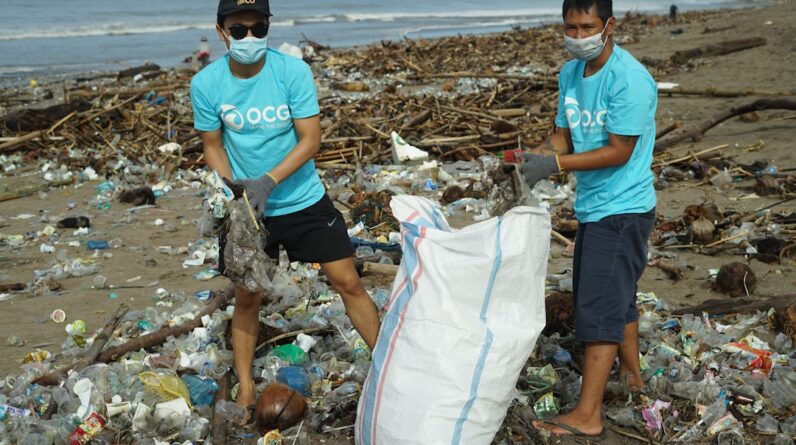
When you think about the sources of oxygen that sustain life on Earth, your mind might immediately drift to lush forests or sprawling green fields. However, the ocean plays an equally vital role in this essential process. Covering more than 70% of the planet’s surface, the ocean is not just a vast body of water; it is a dynamic ecosystem that contributes significantly to the oxygen supply you breathe.
In fact, it is estimated that the ocean produces about 50% to 80% of the oxygen in the atmosphere, primarily through the activities of microscopic organisms. Understanding the ocean’s role in oxygen production is crucial for appreciating the delicate balance of life on Earth and recognizing the threats that this vital resource faces. As you delve deeper into this topic, you will discover how interconnected life is within marine ecosystems and how these systems influence global oxygen levels.
The ocean’s ability to produce oxygen is not merely a byproduct of its vastness; it is a complex interplay of biological processes that have evolved over millions of years. By exploring these processes, you can gain insight into the importance of maintaining healthy oceans and the implications of their degradation on both marine and terrestrial life.
Key Takeaways
- The ocean plays a crucial role in supplying oxygen to the Earth’s atmosphere.
- Oxygen production in the ocean is primarily carried out by phytoplankton through the process of photosynthesis.
- Phytoplankton are important in oxygen production as they contribute to about half of the oxygen in the atmosphere.
- Marine plants and algae also play a significant role in oxygen production in the ocean.
- Human activities such as pollution and climate change are impacting ocean oxygen levels, leading to consequences for marine life and ecosystems.
The Process of Oxygen Production in the Ocean
The process of oxygen production in the ocean primarily occurs through photosynthesis, a biochemical reaction that converts sunlight, carbon dioxide, and water into glucose and oxygen. This process is predominantly carried out by phytoplankton, tiny photosynthetic organisms that float near the ocean’s surface. When sunlight penetrates the water, these organisms harness its energy to produce oxygen as a byproduct.
This natural phenomenon not only sustains their own life but also contributes to the atmospheric oxygen that you rely on for survival. In addition to phytoplankton, other marine plants and algae also play a significant role in this oxygen production process. Seaweeds and seagrasses, for instance, contribute to photosynthesis in coastal areas, further enhancing the ocean’s capacity to generate oxygen.
The intricate web of life in these ecosystems ensures that oxygen production is a continuous cycle, vital for maintaining ecological balance. As you consider these processes, it becomes clear that the health of marine ecosystems directly impacts your own well-being and that of countless other species on Earth.
The Importance of Phytoplankton in Oxygen Production

Phytoplankton are often referred to as the “lungs of the ocean,” and for good reason. These microscopic organisms are not only responsible for a significant portion of global oxygen production but also form the foundation of marine food webs. As you explore their importance, you’ll find that phytoplankton are incredibly diverse, with thousands of species adapted to various environmental conditions.
This diversity allows them to thrive in different oceanic regions, from nutrient-rich coastal waters to the open sea. The role of phytoplankton extends beyond just oxygen production; they also play a crucial part in carbon cycling. By absorbing carbon dioxide during photosynthesis, they help mitigate climate change by reducing greenhouse gas concentrations in the atmosphere.
This dual function makes phytoplankton indispensable not only for marine ecosystems but also for global climate regulation. As you reflect on their significance, it becomes evident that protecting these tiny organisms is essential for sustaining both ocean health and your own quality of life.
The Role of Marine Plants and Algae in Oxygen Production
While phytoplankton are often highlighted for their contributions to oxygen production, marine plants and algae also play a vital role in this process. Seaweeds, for example, are large algae that thrive in coastal waters and contribute significantly to local oxygen levels through photosynthesis. These organisms can grow rapidly and form underwater forests that provide habitat for various marine species.
As you consider their impact, it’s important to recognize that these underwater ecosystems are not only beautiful but also crucial for maintaining biodiversity. Seagrasses are another important group of marine plants that contribute to oxygen production. Found in shallow coastal areas, seagrasses create dense underwater meadows that support a wide range of marine life.
They not only produce oxygen but also stabilize sediments and improve water quality by filtering pollutants. The health of these marine plants is directly linked to the overall health of ocean ecosystems, making their conservation essential for ensuring a sustainable future for both marine life and human populations.
The Impact of Human Activities on Ocean Oxygen Levels
As you examine the relationship between human activities and ocean health, it becomes clear that our actions have profound implications for oxygen levels in marine environments. Pollution from agricultural runoff, industrial waste, and plastic debris can lead to nutrient overloading in coastal waters, resulting in harmful algal blooms. These blooms can deplete oxygen levels as they die off and decompose, creating “dead zones” where marine life struggles to survive.
This phenomenon highlights how interconnected your actions are with the health of ocean ecosystems. Additionally, climate change poses a significant threat to ocean oxygen levels. Rising sea temperatures can alter the distribution and productivity of phytoplankton, while ocean acidification affects their ability to perform photosynthesis effectively.
As you consider these challenges, it’s essential to recognize that addressing human impacts on oceans requires collective action and a commitment to sustainable practices. Your choices—whether they involve reducing plastic use or supporting policies aimed at protecting marine environments—can contribute to healthier oceans and more stable oxygen levels.
The Consequences of Declining Ocean Oxygen Levels

The decline in ocean oxygen levels has far-reaching consequences that extend beyond marine ecosystems. As you contemplate these impacts, consider how reduced oxygen availability affects fish populations and other marine organisms. Many species rely on specific oxygen levels for survival; when those levels drop, it can lead to mass die-offs or shifts in species distribution.
This disruption not only threatens biodiversity but also impacts fisheries and communities that depend on healthy fish stocks for their livelihoods. Moreover, declining oxygen levels can exacerbate climate change effects by reducing the ocean’s ability to sequester carbon dioxide. As phytoplankton populations decline due to changing conditions, their capacity to absorb carbon diminishes, leading to higher atmospheric CO2 levels.
This cycle creates a feedback loop that further threatens both marine and terrestrial ecosystems. As you reflect on these consequences, it becomes clear that maintaining healthy ocean oxygen levels is not just an environmental issue; it is a matter of global significance that affects food security, climate stability, and overall human well-being.
Efforts to Protect and Restore Ocean Oxygen Levels
Recognizing the critical importance of ocean oxygen levels has spurred various efforts aimed at protecting and restoring marine ecosystems. Conservation initiatives focused on reducing pollution and promoting sustainable fishing practices are essential steps toward safeguarding these vital resources. You may find it encouraging to learn about organizations working tirelessly to restore seagrass meadows and coral reefs, which play crucial roles in maintaining healthy oxygen levels.
Additionally, international agreements such as the Paris Agreement aim to address climate change by reducing greenhouse gas emissions and promoting sustainable practices worldwide. By supporting these initiatives or participating in local conservation efforts, you can contribute to a collective movement aimed at preserving ocean health. Every action counts; whether it’s advocating for policy changes or participating in beach clean-ups, your involvement can make a difference in protecting our oceans.
The Future of Ocean Oxygen Production and Its Impact on Life on Earth
As you look toward the future, it is essential to remain hopeful yet vigilant about the challenges facing ocean oxygen production. Advances in scientific research continue to shed light on how we can better understand and protect these vital ecosystems. Innovations in technology may offer new ways to monitor ocean health and track changes in oxygen levels more effectively.
However, your role as an informed citizen is crucial in shaping this future. By advocating for sustainable practices and supporting policies aimed at protecting marine environments, you can help ensure that oceans continue to produce the oxygen necessary for life on Earth. The future of ocean oxygen production is intertwined with your actions today; by prioritizing environmental stewardship, you contribute not only to healthier oceans but also to a more sustainable planet for generations to come.
Understanding the Ocean’s Role in Our Oxygen Supply is crucial for our planet’s health, but it is also important to consider the impact of deforestation on our oxygen levels. Forests play a vital role in producing oxygen and absorbing carbon dioxide, so stopping forest burning and preserving healthy forests is essential. A related article on this topic can be found at Stop Forest Burning: Save Trees and Animals. This article discusses the importance of protecting our forests to maintain biodiversity and ensure a healthy environment for all living creatures. By understanding the interconnectedness of our ecosystems, we can live life with purpose and make a positive impact on our planet.
FAQs
What is the ocean’s role in our oxygen supply?
The ocean produces over half of the world’s oxygen through the process of photosynthesis by marine plants, algae, and phytoplankton.
How does the ocean produce oxygen?
Marine plants, algae, and phytoplankton use sunlight, carbon dioxide, and water to produce oxygen through the process of photosynthesis.
Why is the ocean’s role in oxygen supply important?
The ocean’s oxygen production is crucial for the survival of marine life and also contributes significantly to the overall oxygen levels in the Earth’s atmosphere.
What are the threats to the ocean’s oxygen production?
Climate change, ocean acidification, pollution, and overfishing are some of the threats that can impact the ocean’s ability to produce oxygen.
How can we protect the ocean’s role in oxygen supply?
Protecting marine ecosystems, reducing carbon emissions, and implementing sustainable fishing practices are some ways to help preserve the ocean’s ability to produce oxygen.





